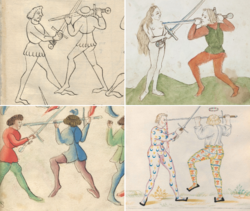|
|
You are not currently logged in. Are you accessing the unsecure (http) portal? Click here to switch to the secure portal. |
Wiktenauer:Main page/Featured
| “Die Blume des Kampfes” | |
|---|---|

| |
| Author(s) |
|
| Illustrated by | Unknown |
| Date | before 1420s |
| Genre | |
| Language | Early New High German |
| State of Existence | Original hypothetical; multiple incomplete copies exist |
| Manuscript(s) |
|
| Concordance by | Michael Chidester |
Die Blume des Kampfes (“The Flower of Battle”) is a nickname given to a group of three German manuscripts which share a common technical syllabus and set of illustrations. It might possibly be based on the tradition of 14th century Italian master Fiore de'i Liberi, from whose treatise Fior di Battaglia it derives its nickname, given that his works include considerable overlap in technique and artwork. It is equally possible, though, that they represent a separate transmission of an older tradition of which Fiore was himself an initiate; Fiore mentions in his prefaces that he owned books on the art and he also names two older masters in his tradition, Johane Suveno and Nicholai de Toblem; it is possible that either or both of those masters authored texts which inspired both this tradition as well as Fiore's own writings.
Like Fior di Battaglia, die Blume des Kampfes treats mounted fencing, spear, poleaxe/halberd, sword (both long sword and short sword), dagger (including dagger against sword), and grappling; it also includes unique content such as armored sword and shield and dueling with long shields. In comparison to their Italic counterparts, the Germanic works place a greater emphasis on short sword fencing, doubling the number of devices, and also dwarf Fiore's own rather brief treatment of unarmored grappling. The dagger, sword, and polearm material is all more or less consistent across both traditions, and the explanatory text, though unconnected to that of Fiore, demonstrates a similar understanding or interpretation of the techniques.
(Read more…)
- Recently Featured:
- Francesco Fernando Alfieri – Johannes Liechtenauer – Jörg Wilhalm Hutter – Jud Lew
